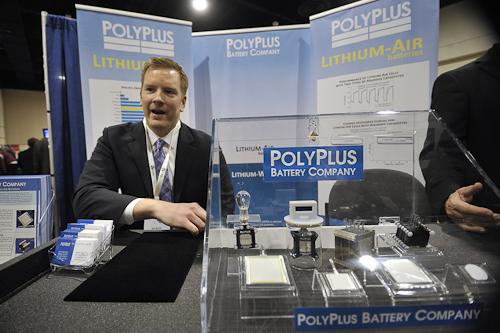
William Mouat explains the PolyPlus battery technology. | Energy Department photo, credit Ken Shipp.
Last night, we had the chance to visit with a few of the researchers and scientists behind the exciting projects on display at the 2011 ARPA-E Energy Innovation Summit Technology Showcase. The following projects represent a few of the highlights we found:
PolyPlus
At Berkeley, CA-based PolyPlus Battery Company, researchers are developing a lithium-air battery that could enable an electric car to travel 500 miles on a single charge. Compared to the best lithium-ion battery technology available today, the rechargeable lithium-air battery prototype that PolyPlus is working on could store more than five times the amount of energy.
Agrivida
Scientists at Agrivida are developing “integrated enzyme-feedstock systems” that they say will transform the biomass conversion process. We spoke with Jeremy Johnson, Vice President of Agrivida, at the Technology Showcase and he told us about their integrated solution for biomass conversion, which is done by modifying the DNA of potential biofuels like switchgrass and sorghum. The company is one of many trying to figure out a way to more effectively convert the energy stored by plants into fuel and effectively transition America off of fossil fuels and increase our energy security. However, current cellulosic production technologies are costly and time-consuming. Agrivida is developing plants that are engineered with cellulose-degrading traits, meaning that their enzymes internally digest their own cellulose on cue, and leave behind a liquid blend of sugars that can be converted into fuel.
OpX Biotechnologies
The scientists at OpX Biotechnologies are taking another innovative approach to biofuel production. Their technology uses hydrogen gas to convert carbon dioxide into biodiesel, for less than $2.50 per gallon. This technology will not rely on photosynthesis, as most biofuels produced today, meaning that the team’s approach bypasses many of the roadblocks to using photosynthesis and will not require the accumulation of plant material, sugar production, vegetable oil, or large amounts of land or water to collect energy from sunlight. If successful, this project will result in billions of gallons of new biofuel production capacity that does not compete for land or commodity crops for food and animal feed.
Cree
Scientists at Cree in Durham, North Carolina are working to demonstrate the major efficiency advantages that advanced silicon carbide power transistors will offer over existing technologies for power substation and other power grid applications. By developing mini-transistors, Cree will be able to replace today’s massive, 8,000 pound distribution transformers with much smaller 100-pound transformers. This will give greater flexibility to increase voltage and move electricity more efficiently over power lines. Lower voltage associated with the current bulky transformers uses up more electricity in transit, making Cree’s high-voltage innovation even more significant. Cree’s power program manager David Grider compared the current power substations, which transfer energy at a much lower voltage than Cree’s technology, to using an ATM that charges an extra $3 just to use the machine. “It’s totally unnecessary,” he told us.

David Grider explains Cree’s technology (Credit: DOE Photo/Ken Shipp)
Codexis, Inc.
California-based Codexis, Inc. is taking another approach to solve problems in the energy industry. They are harnessing biotechnology to develop low-cost enzymes for efficient carbon capture. They also have made significant progress towards developing commercial scale technology that can reduce carbon dioxide emissions from coal-fired power plants. Their innovation uses carbon anhydrase, an enzyme which catalyzes the transfer of carbon dioxide in nature (like the release of CO2 from blood into the lungs during respiration). The challenge in using carbon anhydrase for carbon capture is that the natural enzyme does not function at the high temperatures and harsh industrial conditions in coal-fired power plants. However, the customized enzymes developed by Codexis have been shown to be functional and stable in relatively inexpensive and energy efficient solvents for 24 hours at temperatures up to 75 degrees Celsius. Codexis Vice President Jim Lalonde explained that by using customized carbonic anhydrase enzymes, coal-fired power plants can expect to reduce the energy needed to capture CO2 within the plant by 30%.
Michigan State University
Michigan State University’s technology focused on vehicle technologies, more specifically a wave disk engine that uses a shock wave to compress fuel and increase its energy efficiency. MSU’s wave disk engine can be used to radically improve the fuel consumption efficiency of vehicles. This technology could potentially reduce auto emissions up to 90 percent and substantially decrease fossil fuel use. The wave disk engine -- an engine that is 30 percent less expensive and 30 percent lighter than those in today’s plug-in hybrid vehicles -- overcomes the high cost and weight limitations of current hybrid vehicles and improves the efficiency of the vehicle when using its gasoline engine.

MSU’s Norbert Müller explains the wave disk engine technology to Secretary Chu (Credit: DOE Photo/Ken Shipp)
ABB, Inc.
At ABB, Inc., another innovative company at the Showcase, scientists are developing an advanced superconducting magnet energy storage system (SMES) that will extend the duration of today’s SMES from just a few minutes of power supply to an hour. The technology uses high-performance second generation high temperature superconducting wires that are connected to the electrical power distribution grid using advanced, modular, scalable power electronics converters. We spoke with Dr. Rolando Burgos, who told us that if the system is successful, it will be ideal for use on the electricity grid and cost-competitive to batteries and other energy storage technologies.
General Atomics
Scientists at General Atomics are working to develop a “flow battery” that will be able to store large amounts of energy using chemicals that are stored in tanks outside the battery, unlike traditional lead-acid batteries that work using chemicals stored inside the battery. With chemicals residing in external tanks, the design of General Atomic’s flow battery allows for much more energy to be stored than in today’s lead-acid batteries, at a much lower cost. Not only will the battery provide energy for a lower cost, it will only need replacement once every 20 years. The flow battery can be connected to the electricity grid to provide power or smooth out power from intermittent renewable energy sources like solar and wind.
Sheetak
We also visited the researchers from Sheetak, a company based in Austin, Texas that is designing highly efficient thermoelectric refrigerators that use half the energy and avoid using potent greenhouse gas coolants of traditional vapor-compression refrigeration systems. Sheetak’s Non-Equilibrium Asymmetric Thermoelectric (NEAT) refrigeration system can achieve high performance in solid state refrigeration compressors.
University of Notre Dame
Researchers at the University of Notre Dame are working on two projects supported by ARPA-E. One project seeks to develop a co-fluid vapor-compression cycle based on carbon dioxide and ionic liquids that could drastically improve the efficiency of existing HVAC systems. The other is a project based on carbon capture with ionic liquids. For the latter project, Dr. Joan Brennecke, Director of Notre Dame’s Energy Center, explained that solids (like table salt) at room temperature react with carbon dioxide, turning it into a liquid. When the liquid then turns back into a solid, it releases heat. Thus, in the regeneration step, the heat of fusion of the absorbent could reduce the required energy by as much as 50 percent, dramatically reducing the energy losses required for carbon capture.
For more information about these and other showcased organizations at the ARPA-E Technology Showcase, visit the Summit’s website.




